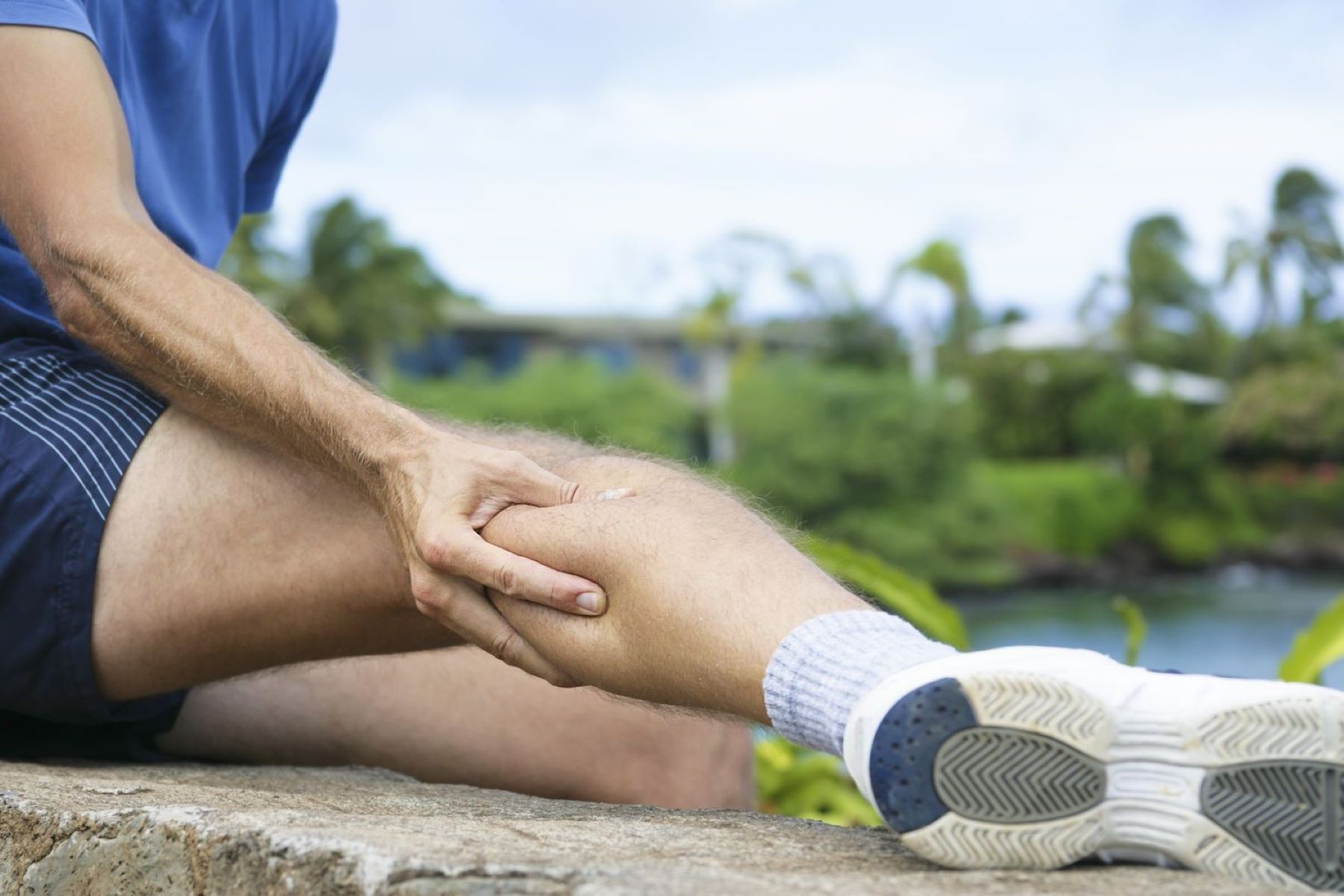Home>Health & Nutrition>Injury Prevention>Signs To Watch For If Your Calf Muscles Spasm


Injury Prevention
Signs To Watch For If Your Calf Muscles Spasm
Published: March 1, 2024
Learn about the signs of calf muscle spasms and how to prevent injuries. Discover effective strategies for injury prevention.
(Many of the links in this article redirect to a specific reviewed product. Your purchase of these products through affiliate links helps to generate commission for Therunningadvisor.com, at no extra cost. Learn more)
Table of Contents
Understanding Calf Muscle Spasms
Calf muscle spasms, often referred to as "charley horses," are involuntary contractions of the muscles in the lower leg. These spasms can range from mild twitches to intense pain and can occur suddenly, catching individuals off guard. Understanding the nature of calf muscle spasms is crucial in effectively managing and preventing them.
The calf muscles, including the gastrocnemius and soleus muscles, play a pivotal role in various movements such as walking, running, and jumping. When these muscles contract involuntarily and fail to relax, it leads to a spasm. The exact cause of calf muscle spasms is not always clear, but several factors can contribute to their occurrence.
Dehydration is a common trigger for calf muscle spasms. When the body lacks an adequate amount of fluids, the muscles are more prone to spasms and cramping. Additionally, overexertion or prolonged physical activity can strain the calf muscles, leading to spasms. This is often observed in athletes or individuals who engage in strenuous exercise without proper conditioning.
Furthermore, electrolyte imbalances, particularly low levels of potassium, calcium, or magnesium, can disrupt the normal function of muscles, increasing the likelihood of spasms. Poor circulation to the calf muscles, often due to prolonged sitting or standing, can also contribute to spasms.
Understanding the underlying causes of calf muscle spasms is essential for effective prevention and treatment. By addressing these factors, individuals can take proactive measures to reduce the frequency and intensity of these spasms. In the following sections, we will delve deeper into the common causes, risk factors, symptoms, and prevention and treatment strategies for calf muscle spasms, providing comprehensive insights to help individuals better manage this discomforting condition.
Common Causes of Calf Muscle Spasms
Calf muscle spasms can be attributed to various factors, ranging from physical exertion to underlying health conditions. Understanding these common causes is crucial for effectively addressing and preventing calf muscle spasms.
-
Dehydration: Inadequate fluid intake can significantly impact muscle function, leading to calf muscle spasms. Dehydration disrupts the balance of electrolytes in the body, particularly sodium, potassium, and magnesium, which are essential for muscle contraction and relaxation. When these electrolyte levels are compromised, the calf muscles are more susceptible to spasms.
-
Overexertion: Engaging in strenuous physical activities without proper conditioning can strain the calf muscles, making them prone to spasms. Athletes and individuals who partake in intense workouts or sports activities may experience calf muscle spasms due to overexertion. The lack of adequate rest and recovery time further exacerbates this risk.
-
Electrolyte Imbalances: Low levels of potassium, calcium, or magnesium in the body can disrupt the normal function of muscles, increasing the likelihood of calf muscle spasms. Potassium, in particular, plays a vital role in regulating muscle contractions. When potassium levels are depleted, the calf muscles may involuntarily contract, leading to spasms.
-
Poor Circulation: Prolonged periods of sitting or standing can impede blood circulation to the calf muscles, causing them to become fatigued and prone to spasms. Inadequate blood flow restricts the delivery of oxygen and nutrients to the muscles, leading to increased muscle tension and susceptibility to spasms.
-
Muscle Fatigue: Continuous or repetitive use of the calf muscles without adequate rest can result in muscle fatigue, making them more susceptible to spasms. This is commonly observed in individuals who engage in activities that require prolonged standing or walking, such as occupations that involve extended periods of standing or walking on hard surfaces.
-
Nerve Compression: In some cases, nerve compression or irritation in the lower back or legs can lead to referred pain and muscle spasms in the calf. Conditions such as sciatica or lumbar radiculopathy can cause nerve impingement, resulting in calf muscle spasms as a secondary symptom.
By recognizing these common causes of calf muscle spasms, individuals can take proactive measures to mitigate the risk factors and minimize the occurrence of these discomforting muscle contractions. Implementing strategies to address dehydration, maintain electrolyte balance, and prevent muscle fatigue can significantly contribute to the prevention of calf muscle spasms.
Risk Factors for Calf Muscle Spasms
Several risk factors contribute to the occurrence of calf muscle spasms, ranging from lifestyle choices to underlying health conditions. Understanding these risk factors is essential for identifying individuals who may be more susceptible to experiencing calf muscle spasms and implementing targeted preventive measures.
-
Dehydration: Inadequate fluid intake can significantly impact muscle function, leading to calf muscle spasms. Dehydration disrupts the balance of electrolytes in the body, particularly sodium, potassium, and magnesium, which are essential for muscle contraction and relaxation. When these electrolyte levels are compromised, the calf muscles are more susceptible to spasms.
-
Overexertion: Engaging in strenuous physical activities without proper conditioning can strain the calf muscles, making them prone to spasms. Athletes and individuals who partake in intense workouts or sports activities may experience calf muscle spasms due to overexertion. The lack of adequate rest and recovery time further exacerbates this risk.
-
Electrolyte Imbalances: Low levels of potassium, calcium, or magnesium in the body can disrupt the normal function of muscles, increasing the likelihood of calf muscle spasms. Potassium, in particular, plays a vital role in regulating muscle contractions. When potassium levels are depleted, the calf muscles may involuntarily contract, leading to spasms.
-
Poor Circulation: Prolonged periods of sitting or standing can impede blood circulation to the calf muscles, causing them to become fatigued and prone to spasms. Inadequate blood flow restricts the delivery of oxygen and nutrients to the muscles, leading to increased muscle tension and susceptibility to spasms.
-
Muscle Fatigue: Continuous or repetitive use of the calf muscles without adequate rest can result in muscle fatigue, making them more susceptible to spasms. This is commonly observed in individuals who engage in activities that require prolonged standing or walking, such as occupations that involve extended periods of standing or walking on hard surfaces.
-
Nerve Compression: In some cases, nerve compression or irritation in the lower back or legs can lead to referred pain and muscle spasms in the calf. Conditions such as sciatica or lumbar radiculopathy can cause nerve impingement, resulting in calf muscle spasms as a secondary symptom.
By recognizing these risk factors, individuals can take proactive measures to mitigate the likelihood of experiencing calf muscle spasms. Implementing strategies to address dehydration, maintain electrolyte balance, and prevent muscle fatigue can significantly contribute to the prevention of calf muscle spasms. Additionally, incorporating regular stretching exercises, staying hydrated, and ensuring adequate rest can help reduce the impact of these risk factors, promoting overall muscle health and reducing the occurrence of calf muscle spasms.
Symptoms of Calf Muscle Spasms
Calf muscle spasms can manifest with distinct symptoms that vary in intensity and duration. Understanding these symptoms is crucial for identifying and addressing calf muscle spasms effectively.
-
Sudden Pain and Tightness: One of the hallmark symptoms of calf muscle spasms is the sudden onset of intense pain and tightness in the calf area. Individuals may experience a sharp, cramping sensation that can range from mildly discomforting to excruciating. This abrupt pain often catches individuals off guard, causing them to instinctively reach for the affected calf.
-
Visible Muscle Contraction: During a calf muscle spasm, the affected muscle may visibly contract and harden, creating a palpable knot or bulge in the calf. This involuntary muscle contraction is a defining characteristic of calf muscle spasms and can be observed externally.
-
Limited Range of Motion: Individuals experiencing a calf muscle spasm may find it challenging to move or flex their foot and ankle. The tightness and pain associated with the spasm can restrict the normal range of motion, making it difficult to walk or bear weight on the affected leg.
-
Localized Tenderness: Following a calf muscle spasm, the affected area may exhibit tenderness and sensitivity to touch. The muscles in the calf region may feel sore and tender, particularly immediately after the spasm subsides.
-
Residual Discomfort: After the acute phase of the spasm, individuals may continue to experience residual discomfort in the calf muscles. This lingering sensation can range from a mild ache to persistent soreness, impacting mobility and overall comfort.
-
Recurrent Episodes: Individuals prone to calf muscle spasms may experience recurrent episodes, with the spasms occurring intermittently over time. The frequency and severity of these episodes can vary, often influenced by factors such as physical activity, hydration levels, and muscle fatigue.
Recognizing these symptoms is essential for prompt intervention and management of calf muscle spasms. By understanding the distinct manifestations of this condition, individuals can take proactive measures to alleviate discomfort, prevent future spasms, and promote overall muscle health. Incorporating targeted stretching exercises, maintaining adequate hydration, and addressing underlying risk factors can significantly reduce the impact of calf muscle spasms, enhancing overall well-being and mobility.
Prevention and Treatment of Calf Muscle Spasms
Preventing and effectively treating calf muscle spasms is essential for minimizing discomfort and promoting overall muscle health. By implementing targeted strategies and interventions, individuals can significantly reduce the frequency and intensity of spasms while enhancing the flexibility and resilience of their calf muscles.
Prevention Strategies
-
Hydration: Maintaining adequate hydration is crucial for preventing calf muscle spasms. Individuals should strive to consume an optimal amount of water throughout the day, particularly before, during, and after physical activities. Electrolyte-rich beverages or supplements can also help replenish essential minerals lost through sweat, supporting optimal muscle function.
-
Stretching Exercises: Regular stretching exercises that target the calf muscles can enhance flexibility and reduce the risk of spasms. Incorporating dynamic stretches, such as calf raises and ankle flexion exercises, can help condition the muscles and improve their resilience to sudden contractions.
-
Warm-Up and Cool-Down: Prior to engaging in physical activities, individuals should perform a thorough warm-up routine to prepare the calf muscles for exertion. Similarly, a proper cool-down session after exercise can aid in muscle recovery and reduce the likelihood of post-exertion spasms.
-
Electrolyte Balance: Consuming a balanced diet rich in potassium, calcium, and magnesium can help maintain optimal electrolyte levels, reducing the risk of muscle spasms. Including potassium-rich foods such as bananas, leafy greens, and citrus fruits in the diet can support muscle function and prevent imbalances.
-
Proper Footwear: Wearing supportive and well-fitted footwear is essential for minimizing strain on the calf muscles. Proper arch support and cushioning can reduce the risk of muscle fatigue and overexertion, particularly during prolonged standing or physical activities.
Treatment Approaches
-
Immediate Relief: When a calf muscle spasm occurs, gentle stretching and massaging of the affected muscle can provide immediate relief. Applying heat or cold packs to the area can help alleviate pain and reduce muscle tension.
-
Hydration and Nutrition: Rehydrating and replenishing electrolytes following a spasm can aid in muscle recovery. Consuming a balanced meal or snack containing potassium, calcium, and magnesium can support muscle function and prevent further spasms.
-
Rest and Recovery: Allowing the affected calf muscle to rest and recover is essential for preventing recurrent spasms. Avoiding strenuous activities that exacerbate muscle fatigue and implementing restorative measures, such as elevation and gentle stretching, can promote healing.
-
Medical Evaluation: In cases of frequent or severe calf muscle spasms, seeking medical evaluation is recommended. Underlying conditions such as nerve compression, circulation issues, or electrolyte imbalances may require targeted interventions for effective management.
By integrating these preventive strategies and treatment approaches into their daily routine, individuals can proactively address calf muscle spasms, reduce their impact, and promote overall muscle health and well-being.















